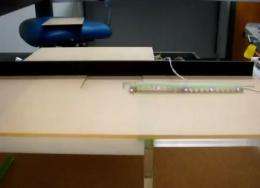GoQBot: Caterpillars inspire new movements in soft robots (w/ video)

(PhysOrg.com) -- Researchers have been examining the diverse behaviours of caterpillars to find solutions for the new generation of search and rescue soft robots.
Despite their extreme flexibility and adaptability, current soft-bodied robots are often limited by their slow speed, leading the researchers to turn to terrestrial soft-bodied animals for inspiration.
Some caterpillars have the extraordinary ability to rapidly curl themselves into a wheel and propel themselves away from predators. This highly dynamic process, called ballistic rolling, is one of the fastest wheeling behaviours in nature.
Researchers from Tufts University, Massachusetts, saw this as an opportunity to design a robot that mimics this behaviour of caterpillars and to develop a better understanding of the mechanics behind ballistic rolling.
The study, published today, Wednesday 27 April, in IOP Publishing's journal Bioinspiration & Biomimetics, also includes a video of both the caterpillar and robot in action:
To simulate the movement of a caterpillar, the researchers designed a 10cm long soft-bodied robot, called GoQBot, made out of silicone rubber and actuated by embedded shape memory alloy coils. It was named GoQBot as it forms a "Q" shape before rolling away at over half a meter per second.
The GoQBot was designed to specifically replicate the functional morphologies of a caterpillar, and was fitted with 5 infrared emitters along its side to allow motion tracking using one of the latest high speed 3D tracking systems. Simultaneously, a force plate measured the detailed ground forces as the robot pushed off into a ballistic roll.
In order to change its body conformation so quickly, in less than 100 ms, GoQBot benefits from a significant degree of mechanical coordination in ballistic rolling. Researchers believe such coordination is mediated by the nonlinear muscle coupling in the animals.
The researchers were also able to explain why caterpillars don't use the ballistic roll more often as a default mode of transport; despite its impressive performance, ballistic rolling is only effective on smooth surfaces, demands a large amount of power, and often ends unpredictably.
Not only did the study provide an insight into the fascinating escape system of a caterpillar, it also put forward a new locomotor strategy which could be used in future robot development.
Many modern robots are modelled after snakes, worms and caterpillars for their talents in crawling and climbing into difficult spaces. However, the limbless bodies severely reduce the speeds of the robots in the opening. On the other hand, there are many robots that employ a rolling motion in order to travel with speed and efficiency, but they struggle to gain access to difficult spaces.
Lead author Huai-Ti Lin from the Department of Biology, Tufts University, said: "GoQBot demonstrates a solution by reconfiguring its body and could therefore enhance several robotic applications such as urban rescue, building inspection, and environmental monitoring."
"Due to the increased speed and range, limbless crawling robots with ballistic rolling capability could be deployed more generally at a disaster site such as a tsunami aftermath. The robot can wheel to a debris field and wiggle into the danger for us."
More information: GoQBot: a caterpillar-inspired soft-bodied rolling robot, Huai-Ti Lin et al 2011 Bioinspir. Biomim. 6 026007 doi: 10.1088/1748-3182/6/2/026007
Abstract
Rolling locomotion using an external force such as gravity has evolved many times. However, some caterpillars can curl into a wheel and generate their own rolling momentum as part of an escape repertoire. This change in body conformation occurs well within 100 ms and generates a linear velocity over 0.2 m s−1, making it one of the fastest self-propelled wheeling behaviors in nature. Inspired by this behavior, we construct a soft-bodied robot to explore the dynamics and control issues of ballistic rolling. This robot, called GoQBot, closely mimics caterpillar rolling. Analyzing the whole body kinematics and 2D ground reaction forces at the robot ground anchor reveals about 1G of acceleration and more than 200 rpm of angular velocity. As a novel rolling robot, GoQBot demonstrates how morphing can produce new modes of locomotion. Furthermore, mechanical coupling of the actuators improves body coordination without sensory feedback. Such coupling is intrinsic to soft-bodied animals because there are no joints to isolate muscle-generated movements. Finally, GoQBot provides an estimate of the mechanical power for caterpillar rolling that is comparable to that of a locust jump. How caterpillar musculature produces such power in such a short time is yet to be discovered.
Provided by Institute of Physics



















